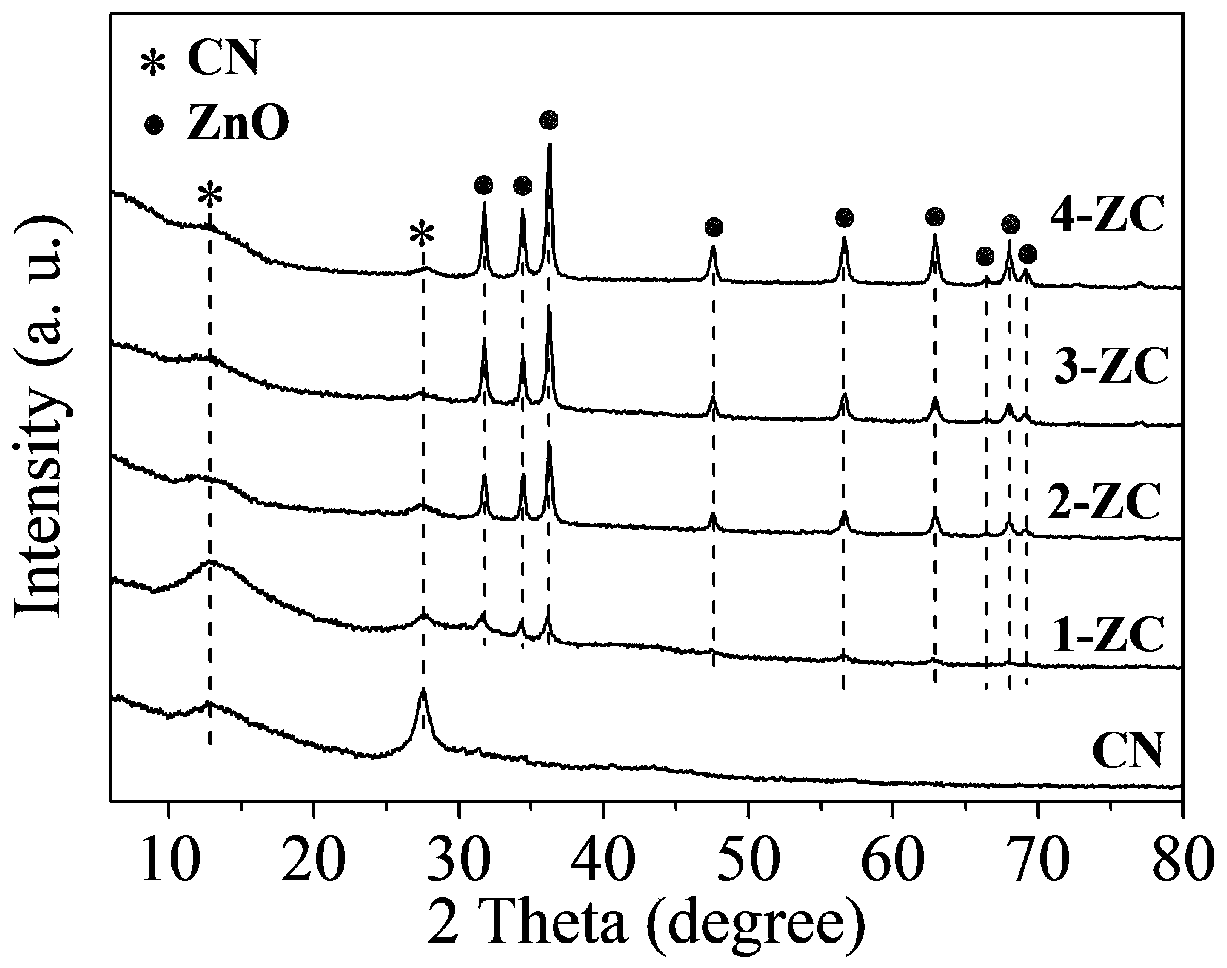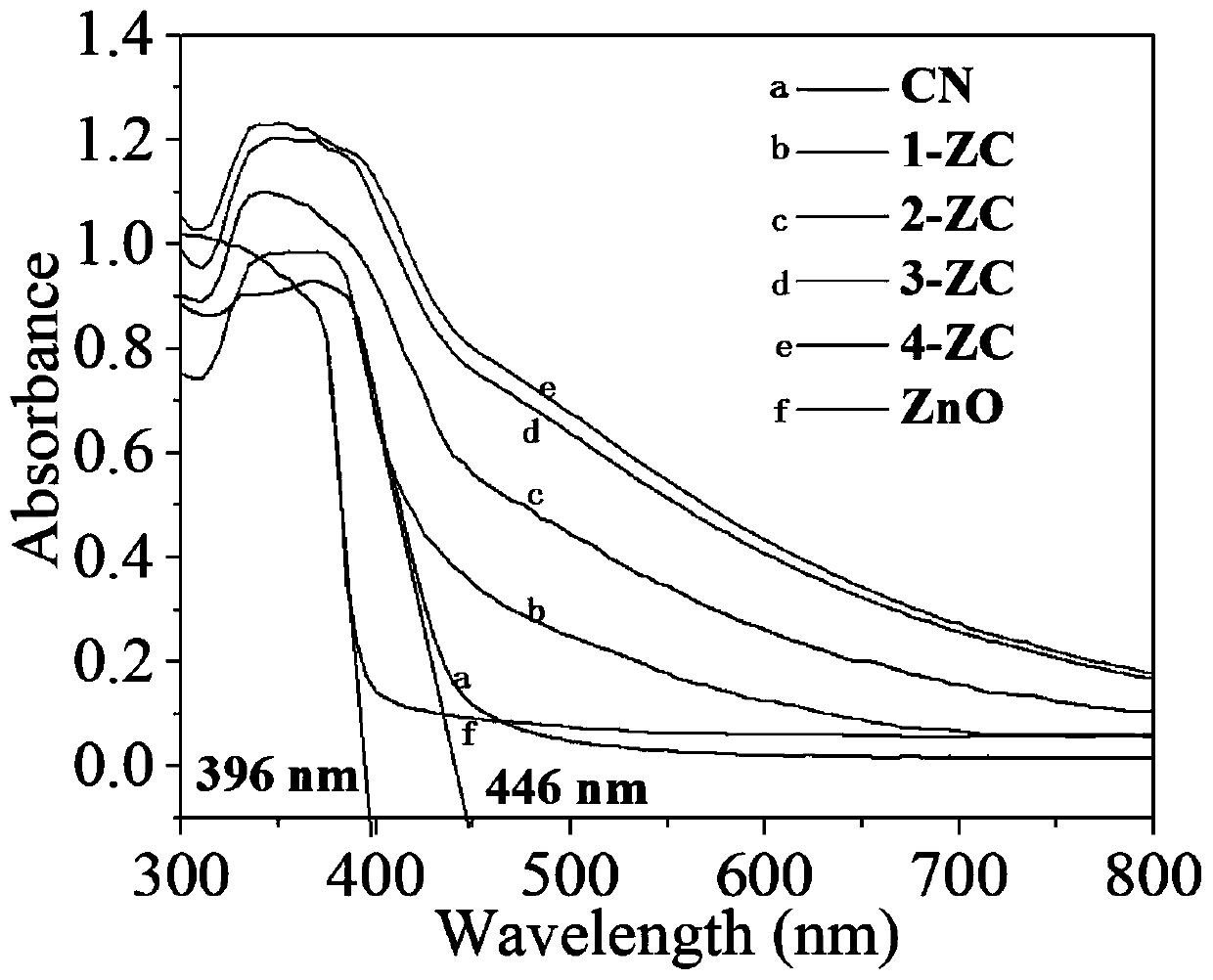Preparation method and application of two-dimensional ZnO/g-C3N4 composite photocatalyst
A technology of g-c3n4 and compound light, which is applied in catalyst activation/preparation, physical/chemical process catalysts, chemical instruments and methods, etc., can solve the problem of high compounding efficiency and achieve the effect of simple operation
- Summary
- Abstract
- Description
- Claims
- Application Information
AI Technical Summary
Problems solved by technology
Method used
Image
Examples
Embodiment 1
[0029] (1) Two-dimensional thin-layer g-C 3 N 4 Precursor preparation:
[0030] Put 10g of urea into an alumina crucible, and calcine it in a muffle furnace at a high temperature of 550°C (the heating rate is 5°C / min) for 4h;
[0031] (2) Two-dimensional thin-layer g-C 3 N 4 Preparation of nanosheets:
[0032] The two-dimensional thin layer g-C 3 N 4 The precursor was added to the nitric acid solution with pH = 1, stirred for 8 hours under the condition of heating in water at 80°C, and then the obtained sample was washed with water several times (to neutral), dried in vacuum at 60°C, and then calcined for 2 hours at 500°C. After cooling to room temperature, the two-dimensional thin layer g-C can be obtained by grinding 3 N 4 Nanosheets.
[0033] (3) Two-dimensional ZnO / g-C 3 N 4 Preparation of composite photocatalyst:
[0034] The Zn (AC 2 ) in the solution and ultrasonically mixed for 30min until completely dispersed, and 50ml of C with a concentration of 0.8mol / ...
Embodiment 2
[0037] (1) Two-dimensional thin-layer g-C 3 N 4 Precursor preparation:
[0038] Put 10g of urea into an alumina crucible, and calcine it in a muffle furnace at a high temperature of 550°C (the heating rate is 5°C / min) for 4h;
[0039] (2) Two-dimensional thin-layer g-C 3 N 4 Preparation of nanosheets:
[0040] The two-dimensional thin layer g-C 3 N 4 The precursor was added to the nitric acid solution with pH = 1, stirred for 8 hours under the condition of heating in water at 80°C, and then the obtained sample was washed with water several times, dried in vacuum at 60°C, and then calcined for 2 hours at 500°C (the heating rate was 5°C / min), after being cooled to room temperature, the two-dimensional thin layer g-C can be obtained by grinding 3 N 4 Nanosheets.
[0041] (3) Two-dimensional ZnO / g-C 3 N 4 Preparation of composite photocatalyst:
[0042] It is the Zn(AC) of 0.6mol / L that the sample gained in 200mg (2) is added to 50ml concentration 2 The solution was ...
Embodiment 3
[0045] (1) Two-dimensional thin-layer g-C 3 N 4 Precursor preparation:
[0046] Put 10g of urea into an alumina crucible, and calcine it in a muffle furnace at a high temperature of 550°C (the heating rate is 5°C / min) for 4h;
[0047] (2) Two-dimensional thin-layer g-C 3 N 4 Preparation of nanosheets:
[0048] The two-dimensional thin layer g-C 3 N 4 The precursor was added to the nitric acid solution with pH = 1, stirred for 8 hours under the condition of heating in water at 80°C, and then the obtained sample was washed with water for several times, dried in vacuum at 60°C, and then calcined for a second time at 500°C for 2 hours, and then cooled to room temperature , Grinding to get two-dimensional thin layer g-C 3 N 4 Nanosheets.
[0049] (3) Two-dimensional ZnO / g-C 3 N 4 Preparation of composite photocatalyst:
[0050] It is the Zn(AC) of 0.8mol / L that the sample gained in 200mg (2) is added to 50ml concentration 2 The solution was mixed and ultrasonicated for...
PUM
 Login to View More
Login to View More Abstract
Description
Claims
Application Information
 Login to View More
Login to View More - R&D
- Intellectual Property
- Life Sciences
- Materials
- Tech Scout
- Unparalleled Data Quality
- Higher Quality Content
- 60% Fewer Hallucinations
Browse by: Latest US Patents, China's latest patents, Technical Efficacy Thesaurus, Application Domain, Technology Topic, Popular Technical Reports.
© 2025 PatSnap. All rights reserved.Legal|Privacy policy|Modern Slavery Act Transparency Statement|Sitemap|About US| Contact US: help@patsnap.com



